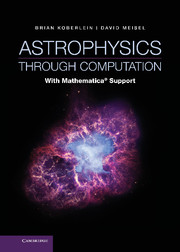8 - Galaxies
Published online by Cambridge University Press: 05 June 2014
Summary
In this chapter we explore several aspects of dynamics within the Milky Way galaxy, including spiral density waves, the effects of dark matter, and the region near the central black hole. We also examine the effects of galactic rotation on stellar clusters by returning to the Orion Trapezium cluster studied in Chapter 6. Finally we look at the role of gas and dust within the galaxy on astrochemistry.
The existence of dark matter
Because of dust obscuration along the galactic equator, radial velocity studies of bright O and B stars in the 1930s and 1940s were able to discern only three or possibly four spiral arm structures in the part of the galaxy nearest the sun. At the time it was assumed that the derived circular orbit velocities fit Kepler's laws, and from that a “reasonable” mass for the galaxy was obtained. That assumption was accepted without much question. After World War II, with the prediction and subsequent discovery of the atomic hydrogen ground state emission called the 21 cm radiation, a new tool was available for measuring the distribution of matter in the Milky Way and other galaxies.
The proton and electron in an ordinary hydrogen atom are both fermions with a spin of ½. As such they both have magnetic moments that can be either parallel or antiparallel. The energy of the bound electron is slightly higher when parallel rather than antiparallel. This creates an energy difference within the ground state, an effect known as hyperfine splitting. When the electron flips a photon is emitted with a frequency of 1420.4 MHz, which corresponds to a wavelength of 21.1 cm. Unlike visible light, these 21 cm radio waves can penetrate cold (∼10 K) dust clouds, which have predominantly molecular rather than atomic hydrogen, that are found within spiral arms. The atomic hydrogen that produces the 21 cm radiation are found in abundance in the “warmer” (∼100 K) space between the cold molecular clouds. When the Dutch radio astronomer Hendrik C. van de Hulst predicted and subsequently found this radiation, the full extent of the galaxy could be observed and characterized.
- Type
- Chapter
- Information
- Astrophysics through ComputationWith Mathematica® Support, pp. 263 - 308Publisher: Cambridge University PressPrint publication year: 2013

